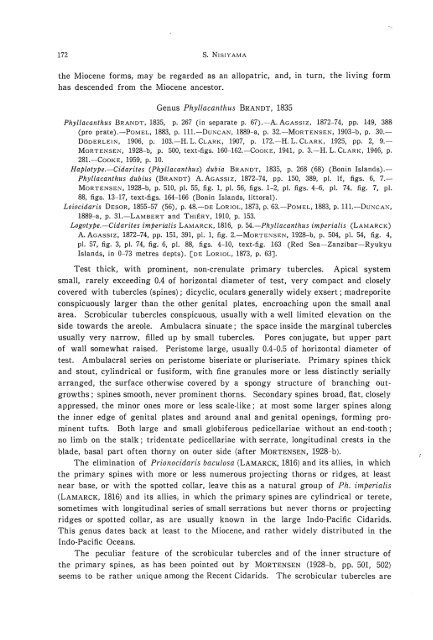the echinoid fauna from japan and adjacent regions part i
the echinoid fauna from japan and adjacent regions part i
the echinoid fauna from japan and adjacent regions part i
You also want an ePaper? Increase the reach of your titles
YUMPU automatically turns print PDFs into web optimized ePapers that Google loves.
172 S. NISIYAMA<br />
<strong>the</strong> Miocene forms, may be regarded as an allopatric, <strong>and</strong>, in turn, <strong>the</strong> living form<br />
has descended <strong>from</strong> <strong>the</strong> Miocene ancestor.<br />
Genus Phyllacanthus BRANDT, 1835<br />
Phyllacanthus BRANDT, 1835, p. 267 (in separate p. 67).-A. AGASSIZ, 1872-74, pp. 149, 388<br />
(pro prate).-PoMEL, 1883, p. l11.-DuNCAN, 1889-a, p. 32.-MoRTENSEN, 1903-b, p. 30.<br />
DbDERLEIN, 1906, p. 103.-H. L. CLARK, 1907, p. 172.-H. L. CLARK, 1925, pp. 2, 9.<br />
MORTENSEl':, 1928-b, p. 500, text-figs. 160-162.-COOKE, 1941, p. 3.-H. L. CLARK, 1946, p.<br />
281.-COOKE, 1959, p. 10.<br />
Haplotype.-Cidarites (Phyllacanthus) dubia BRANDT, 1835, p. 268 (68) (Bonin Isl<strong>and</strong>s).<br />
Phyllacanthus dubius (BRANDT) A. AGASSIZ, 1872-74, pp. 150, 389, pI. If, figs. 6, 7.<br />
MORTENSEN, 1928-b, p. 510, pI. 55, fig. 1, pI. 56, figs. 1-2, pI. figs. 4-6, pI. 74. fig. 7, pI.<br />
88, figs. 13-17, text-figs. 164-166 (Bonin Isl<strong>and</strong>s, littoral).<br />
Leiocidaris DESOR, 1855-57 (56), p. 48.-DE LORIOL, 1873, p. 63.-POMEL, 1883, p. 111.-DuNCAl':,<br />
1889-a, p. 31.-LAMBERT <strong>and</strong> THIERY, 1910, p. 153.<br />
Logotype.-Cidarites imperialis LAMARCK, 1816, p. 54.-Phyllacanthus imperialis (LAMARCK)<br />
A. AGASSIZ, 1872-74, pp. 151, 391, pI. 1, fig. 2.-MoRTENSEN, 1928-b, p. 504, pI. 54, fig. 4,<br />
pI. 57, fig. 3, pI. 74, fig. 6, pI. 88, figs. 4-10, text-fig. 163 (Red Sea-Zanzibar-Ryukyu<br />
Isl<strong>and</strong>s, in 0-73 metres depts). [DE LORIOL, 1873, p. 63J.<br />
Test thick, with prominent, non-crenulate primary tubercles. Apical system<br />
small, rarely exceeding 0.4 of horizontal diameter of test, very compact <strong>and</strong> closely<br />
covered with tubercles (spines); dicyclic, oculars generally widely exsert ; madreporite<br />
conspicuously larger than <strong>the</strong> o<strong>the</strong>r genital plates, encroaching upon <strong>the</strong> small anal<br />
area. Scrobicular tubercles conspicuous, usually with a well limited elevation on <strong>the</strong><br />
side towards <strong>the</strong> areole. Ambulacra sinuate; <strong>the</strong> space inside <strong>the</strong> marginal tubercles<br />
usually very narrow, filled up by small tubercles. Pores conjugate, but upper <strong>part</strong><br />
of wall somewhat raised. Peristome large, usually 0.4-0.5 of horizontal diameter of<br />
test. Ambulacral series on peristome biseriate or pluriseriate. Primary spines thick<br />
<strong>and</strong> stout, cylindrical or fusiform, with fine granules more or less distinctly serially<br />
arranged, <strong>the</strong> surface o<strong>the</strong>rwise covered by a spongy structure of branching outgrowths;<br />
spines smooth, never prominent thorns. Secondary spines broad, fiat, closely<br />
appressed, <strong>the</strong> minor ones more or less scale-like; at most some larger spines along<br />
<strong>the</strong> inner edge of genital plates <strong>and</strong> around anal <strong>and</strong> genital openings, forming prominent<br />
tufts. Both large <strong>and</strong> small globiferous pedicellariae without an end-tooth;<br />
no limb on <strong>the</strong> stalk; tridentate pedicellariae with serrate, longitudinal crests in <strong>the</strong><br />
blade, basal <strong>part</strong> often thorny on outer side (after MORTENSEN, 1928-b).<br />
The elimination of Prionocidaris baculosa (LAMARCK, 1816) <strong>and</strong> its allies, in which<br />
<strong>the</strong> primary spines with more or less numerous projecting thorns or ridges, at least<br />
near base, or with <strong>the</strong> spotted collar, leave this as a natural group of Ph. imperialis<br />
(LAMARCK, 1816) <strong>and</strong> its allies, in which <strong>the</strong> primary spines are cylindrical or terete,<br />
sometimes with longitudinal series of small serrations but never thorns or projecting<br />
ridges or spotted collar, as are usually known in <strong>the</strong> large Indo-Pacific Cidarids.<br />
This genus dates back at least to <strong>the</strong> Miocene, <strong>and</strong> ra<strong>the</strong>r widely distributed in <strong>the</strong><br />
Indo-Pacific Oceans.<br />
The peculiar feature of <strong>the</strong> scrobicular tubercles <strong>and</strong> of <strong>the</strong> inner structure of<br />
<strong>the</strong> primary spines, as has been pointed out by MORTENSEN (1928-b, pp. 501, 502)<br />
seems to be ra<strong>the</strong>r unique among <strong>the</strong> Recent Cidarids. The scrobicular tubercles are












